
by Francisco Sayu | May 24, 2022 | Electrification, Home, Sustainability
Co-author: Jenna Greene
Early April 2022, two people were seriously injured in an explosion caused by attempting to light a propane furnace in their Marinette County home. Approximately 253,000 (primarily rural) households in Wisconsin use propane to heat their homes, putting public safety at risk and creating greenhouse gas (GHG) emissions that negatively impact human health. In addition, propane is currently the most expensive fuel type for Wisconsin residents. Air-source heat pumps can be a safe, efficient, and affordable alternative to propane heat. Wisconsin needs policies, programs, and incentives that accelerate this transition for rural customers.
An air-source heat pump (ASHP) is an electrically powered heating and cooling device that moves heat, rather than generating it, to provide comfortable building temperatures. ASHPs operate “in reverse” in the summer to provide cooling (similar to a refrigerator). Cold-climate air source heat pumps have made significant technological advances in recent years; today, ASHPs can operate in temperatures as low as -22 degrees Fahrenheit. Some local Wisconsin residents and nonprofit organizations are already switching to ASHPs for heating and cooling.
Heating homes with fossil fuels create emissions that impact human health and contribute to climate change – 8% of greenhouse gas (GHG) emissions in Wisconsin come from the residential sector. Climate change threatens the economy in many ways, including increased flooding and storm damage, altered crop yields, lost labor productivity, and strained energy systems. Wisconsin’s electric grid is increasingly powered by renewable energy sources like solar and wind. Transitioning away from propane heat will increasingly reduce GHG emissions.
In 2021, Wisconsin imported 41,000 barrels of propane – valued at more than four million dollars. Spending money on imported energy resources weakens local economies and burdens household budgets. Many Wisconsin residents feel the effects of rising fossil fuel costs, with propane projected to be the most expensive fuel source in 2021-2022. Transitioning to air-source heat pumps can lower annual heating and cooling costs and free Wisconsinites from the volatility of imported fossil fuels.
ASHPs provide safe, efficient, and affordable home heating and cooling. Electricity is generated off-site and delivered to homes, which dramatically lowers the safety risk to families from on-site propane combustion. High-efficiency heat pumps can convert one British Thermal Unit (BTU) of electricity into three BTUs of heating or cooling – significantly more efficient than gas furnaces at most temperatures. ASHPs are also cost-effective compared with propane use. ASHP adopters can save up to $750 per year on heating and cooling costs. We need financing mechanisms to allow households and businesses to finance energy efficiency retrofits and ASHP installations with affordable upfront payments.
Many rural Wisconsin households use propane or heating oil to heat their homes which is expensive, puts people at risk, and sends millions of dollars out of state each year. Wisconsin utilities, policymakers, and Focus on Energy should expand programs to transition households from propane heating to efficient electric heating, saving people money, reducing hazards, and improving health outcomes in rural communities.

by Guest Blog | May 23, 2022 | Community, Community Solar, Solar
Cory Neeley
Director, SolarShare WI Cooperative
This year’s theme for Earth Day was “Invest In Our Planet.” There are many ways to invest in our planet, and I’m excited to announce a brand-new opportunity created in part by RENEW that allows everyday people to invest in Wisconsin’s clean energy economy.
SolarShare WI Cooperative is an innovative cooperative model that helps Wisconsin residents and businesses invest in solar cooperative farms. Working together, our members pool money to invest in solar farms located in Wisconsin, reducing our reliance on imported fossil fuels and strengthening our economy with stable, affordable, renewable energy for our local utilities.
How does SolarShare WI Cooperative Work?
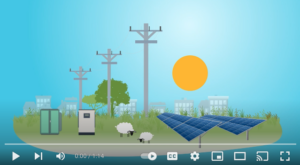
SolarShare WI Cooperative works with Wisconsin-based member contractors to finance, build, operate and maintain the cooperative solar farms, creating family-supporting jobs in Wisconsin and reducing our reliance on energy from outside the state. Profits from the sale of our clean energy are returned to members as dividends, multiplying the economic benefit of our projects.
Cooperative action is woven into the fabric of rural Wisconsin and allows small groups of people to achieve great things. Whether pooling dairy or providing electricity, cooperatives play crucial roles in Wisconsin communities.
Wisconsin imports 14 billion dollars’ worth of non-renewable energy each year. We can keep more of our energy dollars in Wisconsin by working together to invest in local renewable energy.
We plan to build solar farms across the state, partnering with local communities and utilities to provide cost-effective renewable energy while providing financial opportunities to Wisconsin citizens and ratepayers. The investment we make in cooperative solar farms is an investment in our state and, ultimately, our planet.
Please join us at SolarShare WI Cooperative for more information.

by Jodi Jean Amble | May 17, 2022 | Advocacy, Community, Electric Vehicles, Jobs, Local Initiatives, Renewables, Solar, Wind
RENEW Wisconsin has launched two state-wide communications campaigns to promote the benefits of clean energy investments in Wisconsin. The two campaigns, “Clean Energy Works for Wisconsin” and “Clean Energy is Made in Wisconsin,” include print and digital ads and shareable communications assets for partners and clean energy advocates.
Wisconsin’s clean energy workforce is 70,000 strong, with good-paying local jobs like installing solar and electric vehicle charging stations, manufacturing energy storage systems, servicing wind turbines, and retrofitting buildings. Clean energy job growth is gaining momentum from state and federal clean energy and electric transportation commitments, federal funds to support these goals, and an increased interest in clean energy investments from the public sector. The “Clean Energy Works for Wisconsin” campaign highlights the job potential of continued investment in electric transportation and Wisconsin clean energy.
“Over the next five years, Wisconsin can expect to receive $79 million in federal funds from the bipartisan infrastructure law,” said Francisco Sayu, Emerging Technologies Director at RENEW Wisconsin. “Wisconsin will also have the opportunity to apply for $2.5 billion in competitive grant funding dedicated to electric vehicle corridors and community charging. Building a network of electric vehicle charging stations will reduce emissions, improve air quality, and create thousands of good-paying jobs and is a tremendous opportunity for Wisconsin residents.”
In 2019, Governor Evers set a goal that all electricity consumed in the state will be 100% carbon-free by 2050, and in 2022 introduced Wisconsin’s first-ever Clean Energy Plan. Currently, renewable energy only accounts for 13% of all electricity sold in Wisconsin. According to the U.S. Energy Information Administration, Wisconsin consumes almost six times as much energy as it produces and spends billions on coal, oil, and natural gas every year. The “Clean Energy is Made in Wisconsin” campaign presents a vision of keeping more energy dollars in-state by investing in homegrown renewable energy.
“State and federal investments are moving us toward our clean energy goals, but we need to maximize the benefits of this energy transition for Wisconsin residents,” said Heather Allen, Executive Director at RENEW Wisconsin. “We will need an ‘all of the above’ and ‘all hands on deck’ approach to shape our clean energy future. This means smart investments in homegrown renewable energy and clean transportation.”
Print and digital ads are already circulating in media outlets across the state. To learn more and help amplify Wisconsin’s clean energy opportunities, please visit the “Clean Energy Works for Wisconsin” and “Clean Energy is Made in Wisconsin” landing pages.
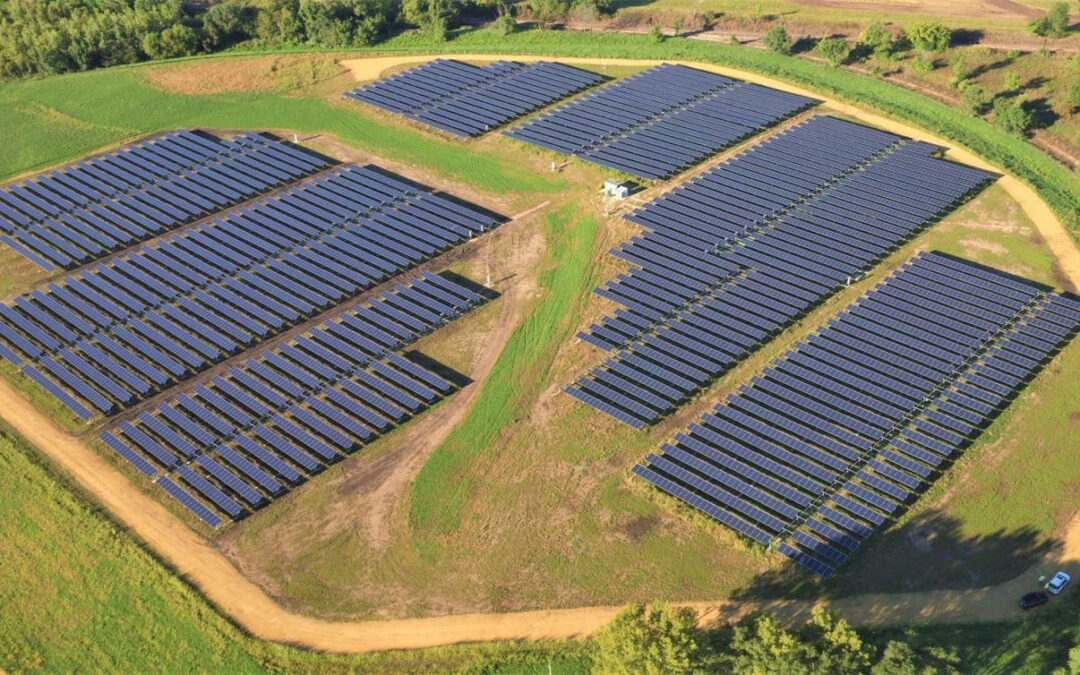
by Michael Vickerman | Apr 28, 2022 | Advocacy, Press Release, PSC Priorities, Solar
But a federal anti-dumping investigation jeopardizes solar power build-out in Wisconsin
Having secured approval today from the Public Service Commission (PSC) to build six more solar power plants, Alliant Energy’s Wisconsin affiliate is on a trajectory to source 20% of its electricity from solar power by 2025.
The PSC decision enables Alliant to construct and operate 414 megawatts (MW) of solar generating capacity in Dodge, Grant, Green, Rock, and Waushara counties. In combination with the 675 MW of projects approved in April 2021, Alliant’s solar power portfolio now consists of a dozen projects totaling more than one gigawatt, or 1,089 MW. Alliant’s approved solar projects are listed in the table below.
Over the last three years, the PSC has approved 1,850 MW of utility-owned solar generating capacity in Wisconsin. Of that total, nearly 60% of that generation will serve Alliant Energy’s Wisconsin customers.
“Today’s approval by the PSC affirms the uniquely valuable set of benefits that large-scale solar will bring to Wisconsin’s power industry,” RENEW Executive Director Heather Allen said. “When placed in service, these 12 solar projects will support the grid long after Alliant retires its coal-fired power plants, generating clean, affordable energy here in Wisconsin while delivering a reliable revenue stream to participating landowners and host communities.”
But a recently initiated U.S. Commerce Department investigation into alleged unfair trade practices has already begun to disrupt utility-scale solar farm development nationwide, including projects in Wisconsin. If not resolved soon, the collateral damage from this investigation will likely spread to the Alliant solar portfolio approved today, causing construction delays and increasing costs.
The investigation, which could extend until August 28th, targets solar products imported from Cambodia, Malaysia, Thailand, and Vietnam. Eighty percent (80%) of all U.S. solar panel imports are sourced from these four countries. If an unfair trade practice is identified, the Commerce Department is empowered to remedy the situation with very high tariffs on panels. For that reason, manufacturers in the targeted countries have been forced to cease production of solar panels destined for U.S. projects.
“Not even a month has gone by, and it is already disrupting solar projects at all stages of the development pipeline,” Allen said. “We are concerned that this investigation can do serious damage to the solar build-out now underway as well as undermine Wisconsin’s Clean Energy Plan.” Allen added: “We ask Senators Baldwin and Johnson and Wisconsin’s Congressional delegation to stand up for Wisconsin jobs, Wisconsin farmers, and Wisconsin’s rural economy and urge the Commerce Department to issue a negative ruling on this matter as soon as possible.”
APPROVED ALLIANT ENERGY SOLAR PROJECTS
| Docket: 6680-CE-183
Approved April 28, 2022 |
| Project name |
Location (county) |
Capacity (in MW) |
| Albany |
Green |
50 |
| Beaver Dam |
Dodge |
50 |
| Cassville |
Grant |
50 |
| Paddock |
Rock |
65 |
| Springfield (Lomira) |
Dodge |
100 |
| Wautoma |
Waushara |
99 |
| Subtotal |
414 |
| Docket: 6680-CE-182
Approved April 21, 2021 |
| Project name |
Location (county) |
Capacity (in MW) |
| Bear Creek |
Richland |
50 |
| Crawfish River |
Jefferson |
75 |
| Grant County |
Grant |
200 |
| North Rock |
Rock |
50 |
| Onion River |
Sheboygan |
150 |
| Wood County |
Wood |
150 |
| Subtotal |
675 |
| Grand total |
1,089 |
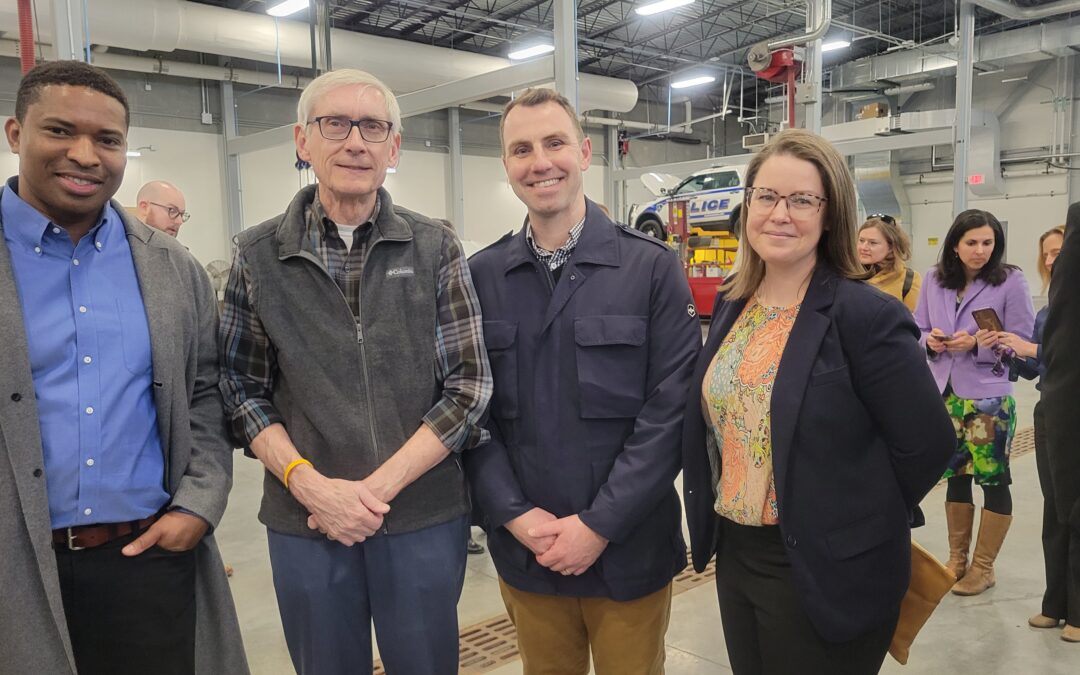
by Heather Allen | Apr 19, 2022 | Electric Vehicles, Energy Storage, Focus on Energy, Jobs, Legislative Watchlist, Local Government, Microgrids, Policy, Press Release, Renewables
Today, Governor Tony Evers introduced Wisconsin’s first-ever Clean Energy Plan. The plan was developed with input from hundreds of stakeholders and provides a pathway for Wisconsin to build a robust clean energy workforce, save billions of dollars, and become more energy independent.
Building a Clean Energy Workforce
The Clean Energy Plan developed by Governor Evers and the Office of Sustainability and Clean Energy (OSCE) identifies opportunities to grow Wisconsin’s clean energy workforce. Wisconsin’s clean energy workforce is 76,000 strong, with good-paying, resilient jobs like installing solar and electric vehicle charging stations, servicing wind turbines, manufacturing energy storage systems, and retrofitting buildings. Wisconsin can take control of its energy future and expand local job creation by investing in renewable energy.
EnTech Solutions, a division of Faith Technologies Incorporated (FTI) based in the Fox Valley, is a leader in distributed energy capabilities, eMobility charging, innovative sustainable fuel technologies, and asset management solutions for businesses looking for reliable, clean energy solutions. “EnTech Solutions is growing to satisfy the high demand for emerging technologies like microgrids, distributed energy systems, and renewable energy EV chargers,” said Tom Clark, chief experience officer with FTI. “Our clean energy workforce develops innovative solutions to solve our customers’ energy challenges.”
The Clean Energy Plan will generate 40,000 new jobs in Wisconsin by 2030, or 6,000 new jobs per year. The plan will create a Clean Energy Workforce Advisory Council and strengthen the workforce with apprenticeship tracks and reentry training for formerly incarcerated individuals. Demand for clean energy workers in Wisconsin is high and growing. State leadership will ensure Wisconsinites have access to training and jobs to help them embark on clean energy careers.
Save Wisconsinites Money
The Clean Energy Plan will accelerate renewable energy and energy efficiency solutions in commercial, residential, and multifamily new construction. Wisconsin families and businesses can save money on monthly energy bills with renewable energy investments, energy efficiency measures, and demand response technologies.
A recent study by Synapse Energy Economics Inc. found that greater investment in Focus on Energy, Wisconsin’s energy efficiency and renewable energy program, would help Wisconsin reap millions in benefits through avoided utility costs, job creation, economic investment, and reduced air emissions. Overall, the report found that if Wisconsin doubled the Focus on Energy budget, the state would receive $340 million in net benefits over one year or $3.4 billion over ten years. The expanded incentives for Focus on Energy outlined in the Clean Energy Plan would create a clean, efficient Wisconsin energy economy for everyone!
Reduce Dependence on Fuel Imports
Wisconsin can be free from the instability of oil and natural gas by investing in renewable energy and electric transportation. Wisconsin currently spends billions of dollars every year to import fossil fuels. The Clean Energy Plan will focus state investments on homegrown, renewable energy and electric vehicle infrastructure.
The Clean Energy Plan will speed the deployment of electric vehicles and charging stations around Wisconsin. The plan lays out strategies for state agencies and local governments to lead the way to build a comprehensive infrastructure for electric vehicle charging stations that will reduce the state and individual dollars spent annually on importing oil and gasoline.
We congratulate Governor Evers and all contributing stakeholders on developing this comprehensive Clean Energy Plan. RENEW is poised to help advance renewable energy, and we look forward to collaborating with state agencies and other partners to build Wisconsin’s clean energy future.
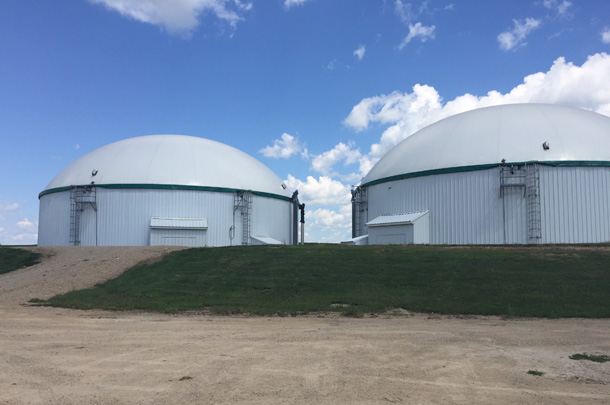
by Guest Blog | Apr 13, 2022 | Biogas, Renewables, Sustainability
Digestion of manure is, on paper, a relatively simple process. Similar to how a cow digests food, digesters further break down manure, capture methane, purify the gas and then convert it to pipeline-grade renewable natural gas (RNG).
Investors of all backgrounds have been touring dairy farms in the U.S. about RNG projects. I’ve heard stories with comments being made such as, “all your nutrient challenges will be gone,” to “we’ll pay you big money for your manure,” to “let’s be in partnership in this project.”
As a former owner of digester facilities, I can tell you that each project is a unicorn. How you bed your cows, frequency, method of manure spreading, and other aspects are just the tip of the iceberg of how farm practices impact the financial outcome of RNG projects.
Incorrect assumptions of owners/investors:
- The stuff coming out the back end is worth money
- Operations and management can be done with a few people
- It’s predictable
- This is a pot of gold at the end of a rainbow
Let’s dig a little deeper into each of these points.
The stuff coming out the back end is worth money.
The effluent does have nutrient value, and it is carbon-based. If separated, the liquid is easy enough to apply. The solids are commonly used as animal bedding, the base for compost, or spread on fields. Additional cost factors come in with the solid not being an easy form to spread on fields. Also, a watershed may require the removal of solids, which can be an added cost for transportation and negatively impact the project’s carbon intensity (CI) score.
Operations and management can be done with a few people
These facilities require people with specific knowledge. At first glance, the facilities are comprised of pipes, pumps, and poop. But there are by-products generated from manure –hydrogen sulfide and ammonia. Those two gasses deliver quite a punch to the equipment.
It is predictable
The aforementioned hydrogen sulfide and ammonia will humble even the best maintenance plan. Additionally, if manure is piped underground, it will require regular jetting due to buildup.
This is a pot of gold at the end of a rainbow.
RNG projects can be attractive financially, thanks to the Low Carbon Fuel Standard (LCFS) in California and Renewable Identification Numbers (RINs) at the federal level. Many factors can influence the actual income, primarily based on the CI score of a project, as mentioned earlier with farming practices and trucking costs. Historically, costs for maintenance have been underestimated. Equipment will break, and spare parts will be needed to keep projects running smoothly. Remember, if you’re not producing gas, you’re not making money.
Most large farming operations have already or are actively considering a biogas facility. The larger the number of cows, the better a project will pencil out. There are still plenty of opportunities for medium to smaller size farms to create a cluster project. These will depend on proximity to a pipeline.
Being mindful of these common misconceptions will put your team on the right track to a successful project. A legislative effort is underway for Wisconsin farm operations to increase access to the pipeline, therefore making projects more accessible. Click here to learn more about this.

Jessica Niekrasz
Principal
Clean Fuel Connects
Email Jessica Niekrasz

by Heather Allen | Apr 12, 2022 | Energy Storage, PSC Priorities, Public Service Commission, Solar, Utilities, Utility Scale
The Wisconsin Public Service Commission (PSC) approved the construction of the 300-megawatt (MW) Koshkonong Solar Energy Center in early April.
Developed by Chicago-based Invenergy LLC, this solar project will provide enough emission-free electricity to power 60,000 Wisconsin homes. It will become one of Wisconsin’s largest renewable energy generators, representing 12% of Wisconsin utility-scale solar projects that have been completed or approved as of today.
The Koshkonong Solar Energy Center will be located in southeast Dane County. In addition to the 300 MW of solar power, the project will feature a 165 MW battery storage component to help bolster grid reliability. WEC Energy Group and Madison Gas and Electric intend to buy the plant for $649 million.
“This project accelerates the state’s and the region’s transition to clean energy,” said Heather Allen, Executive Director at RENEW Wisconsin. “With enough capacity to provide one-fourth of the local solar needed to meet Dane County’s Climate Action Plan, Koshkonong’s approval is a major milestone in the transition to energy independence for the region.”
When energized, the project will generate $1.2 million per year in new revenue for local governments, in addition to lease payments to local landowners. Construction is expected to begin later this year and will likely become operational in 2025.
“The energy storage component of the project will provide up to 660 megawatt-hours of energy storage per day, or approximately the equivalent battery storage capacity of 6,000 electric vehicles,” Allen added. “Battery energy storage adds more flexibility to the project, allowing for energy use when it is needed most.”
Koshkonong is the fourth solar generation project proposed by Invenergy to receive construction approval from Wisconsin regulators and the third to be combined with an energy storage component. The four solar projects developed by Invenergy—Badger Hollow, Paris, Darien, and now Koshkonong—will comprise 1,050 MW of generating capacity when completed. The energy storage facility at Koshkonong will be the largest of its kind in Wisconsin.
In a separate proceeding, WEC Energy Group and Madison Gas and Electric seek permission to add the Koshkonong Solar Energy Center to their growing portfolio of renewable generating plants. The PSC will likely rule on this application before the end of this year.
In the technical hearing leading up to the PSC’s decision, RENEW provided expert testimony documenting the public benefits to be delivered by the Koshkonong solar and storage project. These benefits include:
- Displacing fossil generation with a zero-carbon source of electricity over its 30-year+ lifetime;
- Providing firm capacity at a Dane County location for replacing the 1,100 MW Columbia coal-fired power plant scheduled for retirement in 2024; and
- Supporting Wisconsin’s farm economy through lease payments to participating landowners and new revenues to local governments hosting the project.
Wisconsin currently has over 510 MW of completed utility-scale solar projects with nearly 2000 MW more approved. This upward trajectory of utility-scale solar projects will help Wisconsin meet its 100% carbon-free goals.

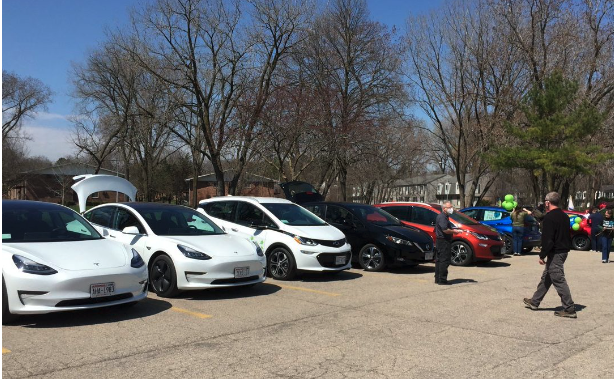
by Francisco Sayu | Apr 11, 2022 | Community, Electric Vehicles, Events, Local Initiatives
On Friday, April 22, 2022, Drive Electric Wisconsin, RENEW Wisconsin, Slipstream, Wisconsin Clean Cities and the Dane County Office of Energy and Climate Change will be hosting an Earth Day Electric Vehicle (EV) Parade in Madison.
A variety of electric vehicles will converge at Demetral Park at 1:00 pm. The parade will depart the park at 2 pm, drive through downtown, make two loops around Capitol Square, and return to Demetral Park. Spectators are encouraged to attend at Demetral Park, Capitol Square, or along the parade route.
All battery electric vehicles (BEVs), plug-in hybrid electric vehicles (PHEVs), electric trucks, and electric motorcycles are welcome to join the parade. For more information and registering for the event, please visit Earth Day EV Parade.
In the Wisconsin transportation sector, GHG emissions are the second-largest source of emissions; EVs currently present the most substantial potential to significantly reduce GHG emissions in the transportation sector, primarily when electricity is generated with low-carbon resources. EVs provide many benefits, including lower maintenance costs, lower fuel costs, zero local emissions, quieter operation, and faster acceleration. As Wisconsin continues to transition to clean energy, the environmental benefits of “driving electric” will continue to increase.
Local residents Carol and Andy Phelps organized Madison’s first Earth Day EV Parade in 2020 as a way to celebrate EVs and Earth Day amid the pandemic. In 2021, more than sixty vehicles joined, RENEW Wisconsin, Slipstream and Dane County Office of Energy and Climate Change for the second Earth Day EV Parade. Many EVs and electric motorcycles are expected at this year’s parade, including Ford, Volkswagen, GM, Tesla, Nissan, Hyundai, Kia, Toyota, Audi, Porsche, BMW, Mercedes-Benz, and Harley Davidson.
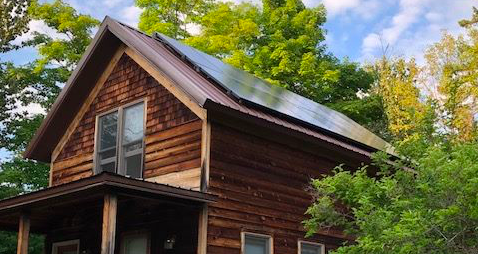
by Heather Allen | Mar 25, 2022 | Advocacy, Net Metering, PSC Priorities, Solar
RENEW Wisconsin, together with a coalition of Clean Energy Advocates (Clean Wisconsin, Environmental Law, and Policy Center, Vote Solar, The Nature Conservancy, Wisconsin Conservation Voters, and the Wisconsin Health Professionals for Climate Action), submitted comments this week to the Public Service Commission in favor of protecting and improving net metering in Wisconsin.
The Commission asked for remarks on four key questions and shared a 60-page memo from the Regulatory Assistance Project describing net metering policy issues, changes to net metering in other states, and several other aspects for consideration. The comment period closed on Tuesday, March 22, 2022.
Wisconsin’s customer-owned solar market is falling behind our neighboring states due to a patchwork of service terms and artificial market barriers. Our coalition comments highlighted several key factors contributing to the issue:
- The absence of a statewide net energy billing policy has fostered an inconsistent and confusing patchwork of tariffs across Wisconsin.
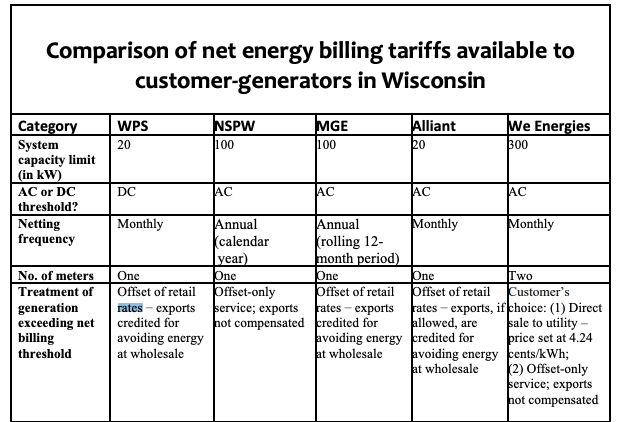
2. Low net energy billing ceilings and low export rates effectively exclude many larger customers from investing in solar systems.
3. Encroachment of utility-owned DG reduces behind-the-meter installation opportunities for customers and solar contractors.
4. The lack of clarity over third-party financing hampers the solar marketplace.
Solar installers, solar customers, clean energy advocates, and climate activists submitted comments echoing these themes. Here are some quotes from the commenters:
“The time has come for the Wisconsin Public Service Commission (WiPSC) to take a customer-centric approach to address the need for dramatic greenhouse gas emission reductions.”
Kerry Beheler and Gary Radloff
Wisconsin GreenFire
“Larger commercial and industrial customers should be allowed to net meter on larger projects that help them displace a greater percentage of their usage with on-site renewable generation. Adjacent states have raised net meter limits above 1000 kW for these customers. State goals of increased renewable energy are efficiently met with an on-site generation that is offsetting load, and this also possibly reduces the need for additional transmission infrastructure. Net metering is one good tool encouraging on-site renewable generation.”
Weselley Slaymaker
“I support a robust net metering policy for Wisconsin. The adaptation of solar power is critical for our energy independence and to mitigate the impact of climate change.”
Megan Stansil
RENEW and its allies explained their priority to improve net metering in the near term to “make net billing tariffs more consistent across Wisconsin utilities.” But we also urged caution that no other reform that could diminish customers’ value proposition for investing in these grid-beneficial technologies should be pursued before reaching much higher solar penetration levels and analyzing the impact of such potential changes.
Net metering is a valuable tool that helps customers generate their energy in a manner that provides both system and public benefits, including carbon emission reduction and economic development. It drives solar deployment and is easily understood and accessible to customers. RENEW will continue to participate in this conversation at the Commission and share results as this process moves forward. Wisconsin can improve customer transparency with a more uniform statewide approach but should be very cautious about risking the benefits of distributed generation by altering rate design.
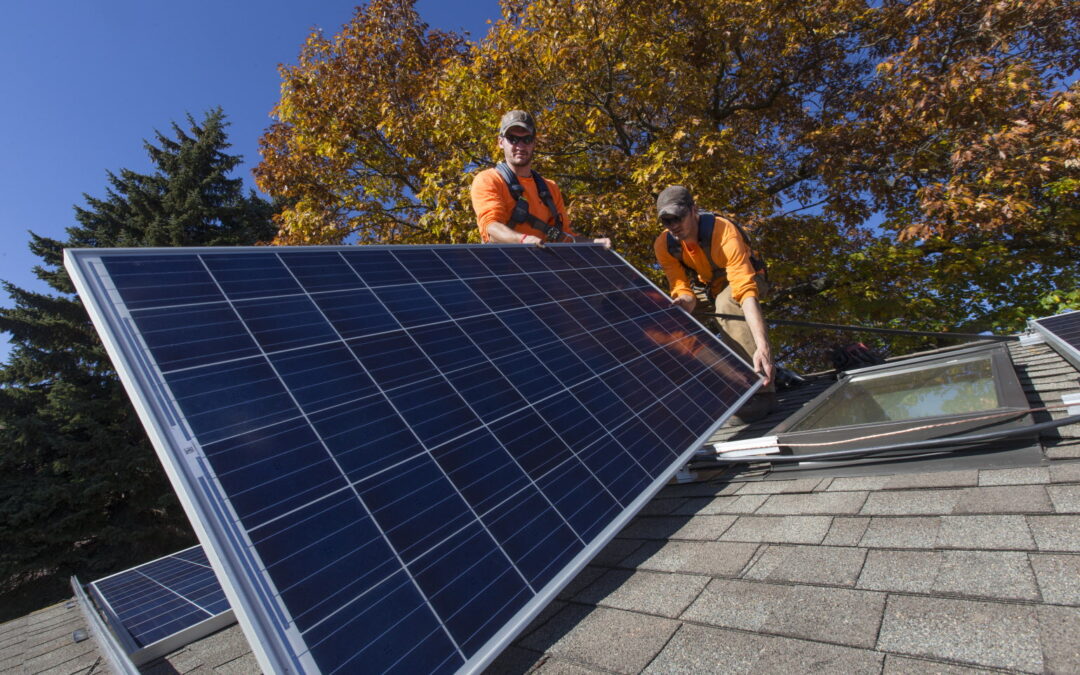
by Sam Dunaiski | Mar 24, 2022 | Local Initiatives, Renewables, Solar, Utilities
On Tuesday, March 22, 2022, the City of Madison and RENEW Wisconsin announced the 2022 MadiSUN residential solar group buy program. MadiSUN is for Madison-area homeowners looking to install solar-electric systems.
In its seventh year, the program offers Dane County homeowners easy access to qualified solar contractors at a competitive price. MadiSUN has spurred approximately $3.5 million in solar energy investments since 2016 and has added over 1,000 kilowatts of renewable electricity to the local electric grid. Over 200 homes in the Madison area have installed solar through the program.
“The MadiSUN program helps make it easy for residents to select an installer and get a cost-effective and high-quality solar system for their home,” said Stacie Reece, Sustainability Program Coordinator for the City of Madison. “Each additional rooftop installation gets us closer to our goal of 100% renewable energy for the City.”
Two local solar installation firms, Arch Solar and Full Spectrum Solar won a competitive bidding process and will design and install arrays for MadiSUN participants. Many solar design firms across Wisconsin anticipate a busy year for installations as Federal Investment Tax Credits begin to wind down in 2023.
“With tax credits at 26%, and utility rates increasing across the state, 2022 is a great year to go solar,” said Stanley Minnick, Head of Sales at Arch Solar, one of the participating contractors for MadiSUN. “This will likely be a record-setting year for residential solar.”
MadiSUN also provides homeowners with multiple options for financing. Loans are available through greenpenny bank and the Clean Energy Credit Union. However, homeowners may choose any financing mechanism they prefer, including home equity lines of credit or loans from other banks.
“Residents of Dane County can count on greenpenny for fast, easy, and affordable financing for their solar projects,” said Jason MacDuff, President of greenpenny. “Our team works hard to find a loan term within our residential solar program that allows for the borrower to trade their current electric bill for a solar financing payment.
In addition to financing and access to local solar contractors, MadiSUN participants have access to additional education sessions, which help them understand the benefits of at-home solar energy.
“Modern solar electric systems are still relatively new technology to many Wisconsin homeowners,” stated Sam Dunaiski, Distributed Resources Director for RENEW Wisconsin and administrator of the MadiSUN program. “The main goal of MadiSUN is to make going solar easy and affordable for any Madison area resident. We want to make sure everyone in the community understands how beneficial solar energy can be.”
Residents can receive a complimentary solar assessment by visiting madisunsolar.com and filling out the “I’m Interested” form. Applications for the Group Buy program must be submitted by August 31, 2022.














